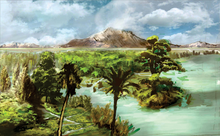Cheirolepidiaceae
| Cheirolepidiaceae Temporal range:
| |
|---|---|

| |
| Cheirolepidiaceae in a Danian landscape (reconstruction by F. Guillén) | |
| Scientific classification | |
| Kingdom: | Plantae |
| Clade: | Tracheophytes |
| Clade: | Gymnospermae |
| Division: | Pinophyta |
| Class: | Pinopsida |
| Order: | Pinales |
| Family: | †Cheirolepidiaceae Turutanova-Ketova 1963 |
| Genera | |
Cheirolepidiaceae is a family of extinct coniferous plants that had a global distribution 259.0 to 61.7 Ma.[1]
This family of conifers, superficially similar to Cupressaceae, was a significant part of the flora of the Mesozoic, around 252 to 66 million years ago.[2] They are united by the possession of a distinctive pollen type assigned to the form genus Classopollis. The name Frenelopsidaceae (as a separate family) or "frenelopsids" has been used for a group of Cheirolepidiaceae with jointed stems, thick internode cuticles, sheathing leaf bases and reduced free leaf tips.
Some species are thought to have been the first plants to be insect pollinated as they occur in association with extinct pollinating scorpionflies.[3]
The family name Hirmeriellaceae is a junior synonym of Cheirolepidiaceae.[4]
References
- ^ "†family Cheirolepidiaceae". Fossilworks. Retrieved 11 February 2018.
- ^ Axsmith, B. J.; Krings, M.; Waselkov, K. (2004). "Conifer pollen cones from the Cretaceous of Arkansas: implications for diversity and reproduction in the Cheirolepidiaceae" (PDF). Journal of Paleontology. 78 (2): 402–409. doi:10.1666/0022-3360(2004)078<0402:CPCFTC>2.0.CO;2. Retrieved 11 February 2011.
{{cite journal}}: Invalid|ref=harv(help) - ^ Ren D, Labandeira CC, Santiago-Blay JA, Rasnitsyn A, Shih CK, Bashkuev A, Logan MA, Hotton CL, Dilcher D. (2009). Probable Pollination Mode Before Angiosperms: Eurasian, Long-Proboscid Scorpionflies. Science, 326 (5954), 840-847.doi:10.1126/science.1178338
- ^ Herendeen, P., 2015. Report of the nomenclature committee on fossils. 9. Taxon (64) 6: 1306-1312
